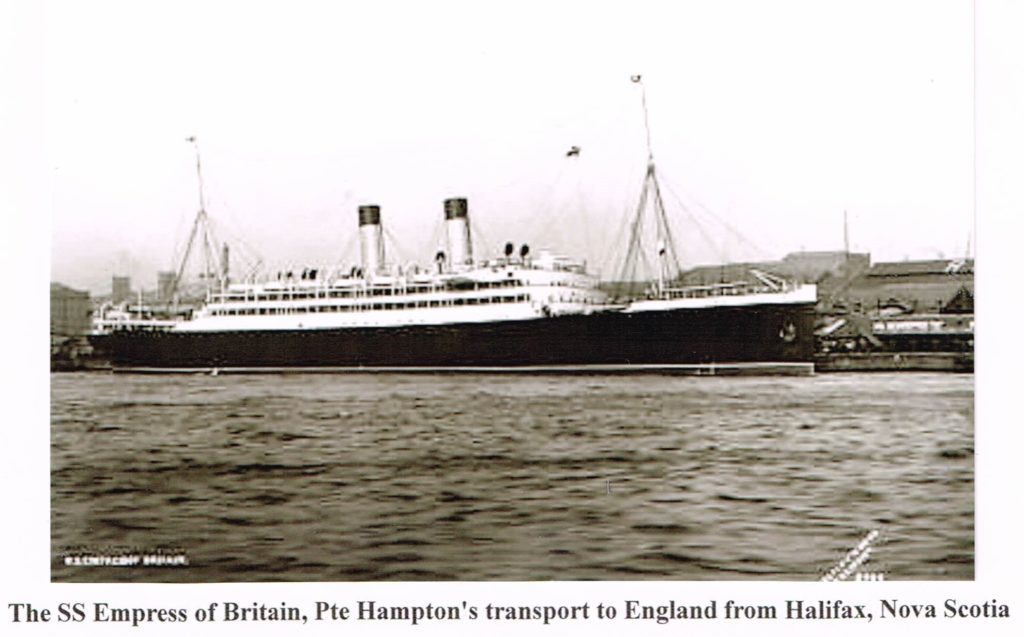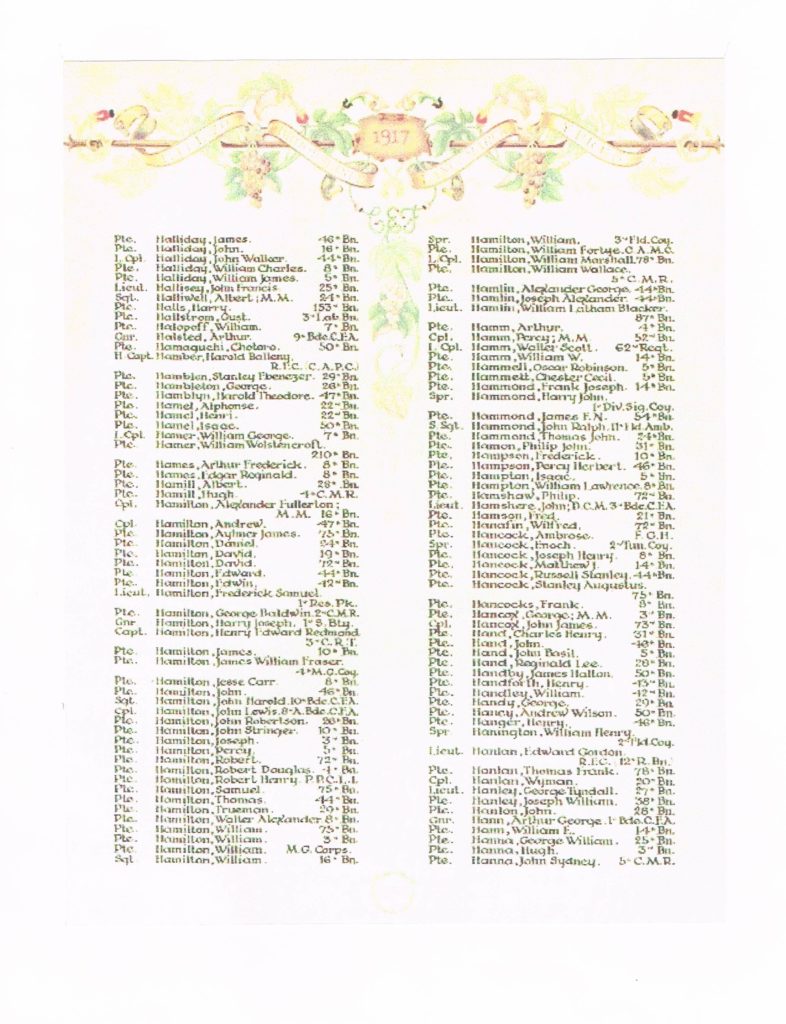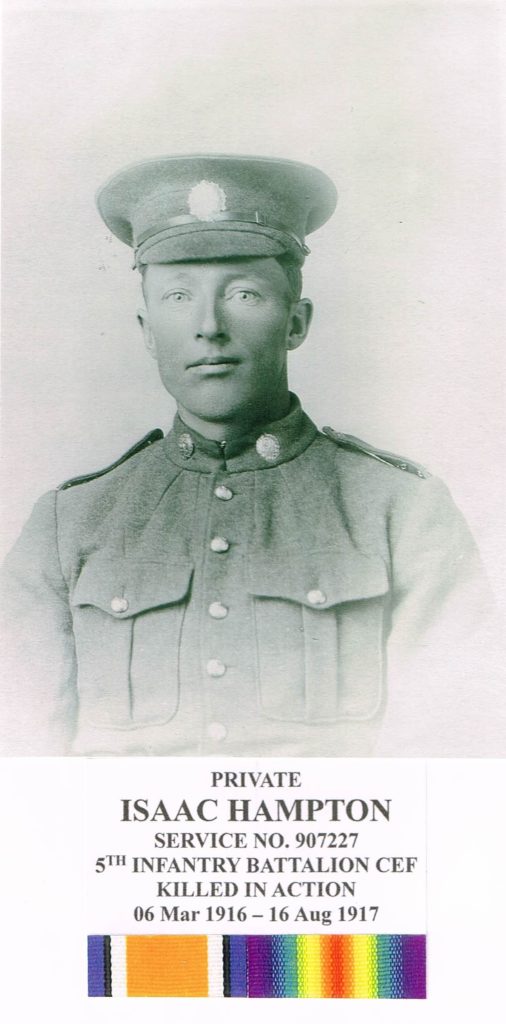MILITARY HISTORY
Private Isaac Hampton – 907227 – ACTIVE SERVICE (World War I)
On March 6, 1916 Isaac Hampton completed the Attestation Paper for the Canadian Army, Canadian Expeditionary Force (CEF). He was 25 years and 7 months old when, as a single man, he enlisted for the duration of the War. Isaac indicated that he was born in Lakefield, Ontario and gave his birth-date as August 6, 1890. He indicated that; he did not presently belong to a Militia Force nor had any previous Military experience. There is nothing on his File to indicate where he was educated or to what level. As far as his Trade or Calling is concerned, he lists Farmer. Isaac was 5′ 8” inches tall, with a 38” chest (expanded). There is no indication of his weight on enlistment. He had a fair complexion with blue eyes, and brown hair. His Medical Examination was completed March 6, 1916 in Regina, Saskatchewan. He had no medical issues or physical limitations and as such he was deemed fit for Overseas duty with the CEF. His next-of-kin was listed as his father, Mr. William Hampton of Lakefield, Ontario. Isaac Hampton signed the Oath and Certificate of Attestation on March 6, 1916 in Regina, Saskatchewan. He was taken-on-strength with the 195th Overseas Battalion (Bn) as a Private (Pte) and was assigned Service Number 907227.
There is nothing in Pte Hampton’s Military File to indicate where he and the 195th Bn trained but, based on the dates and research on the Internet, it was more than likely training took place at Camp Hughes, 10 Kms west of Carberry, Manitoba. Pte Hampton and the 195th Bn embarked from Halifax on either October 31st or November 1st, 1916 (both dates appear in the Military File) aboard the SS Empress of Britain.

The SS Empress of Britian arrived in Liverpool, England on November 11, 1916 where Pte Hampton and the 195th Bn disembarked. On November 14, 1916 he was taken-on-strength with the 32nd Battalion, CEF at East Sandling, England. On January 4, 1917 Pte Hampton was struck-off-strength from the 32nd Bn and on the same day he was taken-on-strength with the 15th Reserve Battalion. On January 12, 1917 Pte Hampton was admitted to the Moore Barracks Canadian Hospital at Shorncilfffe with Parotiditis (Mumps). He was discharged on February 4, 1917 and rejoined the 15th Reserve Bn.
Pte Hampton’s File indicates that on February 18, 1917 he was reported ”on command” to the 14th Reserve Bn. On April 17, 1917 he ceased to be ”on command” to the 14th Reserve Battalion on his return to the 15th Reserve Bn. April 19, 1917 Pte Hampton made out his Military Will providing all of his savings to his mother Mrs. William Hampton. On April 25, 1917 he was struck-off-strength from the 15th Reserve Battalion upon transfer to the 5th Canadian Infantry Battalion (Can Inf Bn). On this day he proceeded Overseas from Bramshott, England. He arrived at the Canadian Base Depot at Le Havre, France on April 26, 1917. Pte Hampton left to join the 5th Can Inf Bn (Saskatchewan Regiment) in the Field on May 13, 1917; he arrived on May 16, 1917.
The 5th Can Inf Bn was attached to the 2nd Canadian Infantry Brigade – 1st Canadian Division.
There are no entries in his File from May 16, 1917 to August 16, 1917.
To track his movements during this period, the War Diary of the 5th Canadian Infantry Battalion (5th Can Inf Bn) was used.
When Pte Hampton joined the 5th Can Inf Bn on May 16th, 1917 the Bn was billeted at Houdain, France, where they would spend the rest of the month in training.
June 1917 on June 1st the Battalion moved from Houdain to Reserve Camp FII. On the 2nd they proceeded to a Divisional Reserve position taking over from the 15th Can Inf Bn. The 3rd to the 8th were spent in work parties. On the 9th the Battalion was relieved by the 4th Can Inf Bn and upon relief proceeded to the Divisional Reserve at Camp FII. The 10th to 13th were spent training by Companies. On the 14th they moved to billets at Le Pendu Huts. The 15th and 16th were spent in training. On the 17th the Battalion left Le Pendu Huts and proceeded to Divisional Reserve. Later in the evening they moved up to Brigade Support. The 18th to 25th were spent in work parties. On the 26th the Battalion was relieved by the 14th Can Inf Bn and it moved back to Brigade Reserve taking over from the 2nd Can Inf Bn. The 27th to 29th the enemy shelled Battalion positions during the day, resulting in a few casualties. The evening was spent in work parties improving the trenches. On the 30th the Battalion was relieved by the 8th Can Inf Bn and moved back to Divisional Support in the area of Neuville St. Vaast.
July 1917 the 1st and 2nd were spent in work parties digging a communication trench over to Vimy Ridge. On the 3rd the Battalion moved back to Le Pendu Huts. The 4th was spent in getting ”cleaned and smartened up” and also kit inspections. The 5th was spent in training by Companies. Training continued the morning of the 6th with a parade to baths at Bethonval Farm in the afternoon. Lewis gunners were in special training. Training continued through to the 10th. The Battalion received a warning order to prepare to relieve the 14th Can Inf Bn in the Front-Line on the night of 11th and 12th. The Battalion was told on the 11th to be prepared to move on short notice. On the 12th the Battalion moved to Ohlain in preparation to moving into the Front-Line on the night of the 15th. The 13th was spent in training and kit inspections. On the 14th they moved to Les Brebis. Here they received a warning to prepare to move into the Front-Line relieving a Battalion of the Essex Regiment. On the 15th the Battalion moved into the trenches. It was reported that the enemy were fairly quiet. There was some shelling of the Battalion area, and enemy pineapples were used on the Front-Line, but no casualties occurred. No Man’s Land was patrolled at night with no enemy encountered. On the 16th enemy activity was up. A considerable number of pineapples were used against the Battalion Front-Line. Some casualties occurred as a result.
“Pineapples” was Trench Slang for German Grenades that were either hand thrown or fired by Mortars.
The enemy was quiet during the 17th, except for the usual shelling of rear areas and pineapples on the Front-Line. The men were engaged in work parties. The 18th was spent in the usual work parties. At night Patrols went out into No-Mans-Land, but did not find any enemy. The 19th was a repeat of previous days
activities. On the 20th the Battalion was relieved by the 8th Can Inf Bn. Upon relief the Battalion moved to billets at Hersin. The 22nd and 23rd were spent in carrying parties in the morning and training by Companies in the afternoon with special emphasis on Squad and Platoon Drills. On the 24th the Battalion paraded in Companies on the practice ground east of Aux Noulettee – Bully Grenay Road in preparation for the coming operation. On the 25th the Officers and NCOs of the Battalion paraded to the C.T. Brigade School at Houchin to look over taped course. On the 26th the Officers and NCOs spent the day going over the plan for the upcoming attack. The Battalion paraded to Hersin for baths. The 28th and 29th were spent in special training for the pending attack. On the 30th the men of the Battalion paraded for Inspection by the Commanding General of the 1st Canadian Division. A warning order was received for the Battalion to be prepared to move into the Front-Line. In the afternoon the order was canceled. On the 31st the Battalion paraded for Gas Test at the 2nd Canadian Infantry Brigade Gas School at Houchin for training. In the afternoon, Squads and Platoons continued with training and practicing attack procedures.
August 1917 the 1st began with the Battalion being warned to proceed to trenches, in the evening, to relieve the 1st Can Inf Bn. At 4:00 PM the warning was canceled. The evening of the 2nd they started to move towards the Front-Line. The relief of the 1st Can Inf Bn in the Front-Line was in the right Sector in front of the village of Loos was completed by 2:00 AM on the 3rd with only minor casualties. The trenches turned out to be very muddy and water logged in places. Visibility was reported as very poor with very little artillery activity. ”A & B” Companies supplied men to carry ammunition and Stokes shells to the trenches. On the 4th Allied artillery was very active, while enemy activity was low. Men were busy in work parties improving the drainage of trenches. The Battalion was relieved by the 10th Can Inf Bn on the 5th. Relief was complete by 3:30 AM. They moved to billets at Les Brebis. On the 6th the Battalion moved to Braquemont. The 7th to 11th were spent training independently in Companies. On the 12th an order was received to relieve the 4th Can Inf Bn on the night of the 13th. The Battalion relieved the 4th Can Inf Bn on the Front-Line of the right Sector of the 1st Can Div in front of Loos. Relief was completed by 2:30 AM with no casualties. After dark on the 14th the men of the Battalion moved out in front of the Front-Line, digging themselves in, ready for the attack that was to take place on the 15th. On the 15th the Battalion attacked. The plan was to have the Battalion attack on a two Company Front in two waves each. ”C & D” Companies were to capture the German Front-Line. ”A & B” Companies would then to pass through them and capture the Blue Line. ”A & B” Companies were then to follow up and clear the ground between the German Front-Line and Blue Line. These objectives taken, the 8th Can Inf Bn was to pass through the 5th Can Inf Bn and move forward and capture the Red and Green Lines. ”A & B” Companies would then mop up between the Blue and Red lines. Sharp at 4:25 AM the barrage opened up and the attack was launched. Two minutes later the barrage moved forward and the men of ”C & D” Companies began the advance. The German Line was taken with very little enemy opposition and very few Battalion casualties. ”C & D” Companies dug in about 40 yards past the old German Front-Line. The position was now heavily shelled by the enemy resulting in casualties. ”A & B” Companies came forward following the advancing Allied barrage. The Companies took a large number of casualties from enemy machine gun positions before reaching their objective (Blue Line). As they approached the Blue Line a number of Germans jumped up as soon as the Allied barrage had moved on only to run into it as they attempted to retreat. Other Germans kept up a steady stream of machine gun fire and trench mortars right up to last minute on the advancing men of ”A & B” Companies. As the barrage lifted from the Blue Line, the 8th Can Inf Bn moved through the 5th Can Inf Bn and after taking heavy losses capturing the Red Line they were considered to be too weak to carry the attack to the Green Line. ”A & B” Companies began work to consolidate the new position, while ”C & D” Companies carried up Grenades and ammunition. The casualties incurred by the Battalion in capturing these positions were about 125. The Battalion Reserve party of 52 men came forward to act as stretcher bearers. On the evening of the 15th the men of ”A & B” Companies relieved the 8th Can Inf Bn in the Front-Line and ”C & D” Companies moved up to the Blue Line.
August 15/16 1917 Pte Hampton was reported from Base – missing. On the 16th it was reported ”previously reported missing now believed killed”. Another entry on August 30, 1917 states: reported ”missing between August 15/16, 1917”. September 7th another entry indicates ”previously reported missing now believed killed-in-action August 16, 1917”. On February 2, 1918 an entry states: ”previously reported missing now for official purposes presumed to have died on or since August 16th, 1917”.
Private Isaac Hampton name is memorialized on the Vimy Memorial at Pas de Calais, France His name appears on page 250 of the First World War Book of Remembrance in Ottawa.
There is a note in his File indicating that Pte Hampton was not eligible to receive the 1914 – 15 Star.
There is no reference, in Private Isaac Hampton’s Military File indicating what Military Medals he was awarded but based on his Military Service, he should have received:
British War Medal 1914 – 1920; and
Victory Medal.
He also qualified for War Service Badge CEF Class “A”.
Private Isaac Hampton’s Medals and Decorations, as well as the Memorial Cross were sent to his mother Mrs. Elizabeth Hampton of Lakefield. The Memorial Plaque and Scroll were sent to his father Mr. William Hampton, also of Lakefield. The Memorial Scroll was sent November 17, 1920 and the Memorial Plaque sent September 28, 1922.
Based on his Military File, Private Issac Hampton served a total of 1 year, 5 months, and 9 days with the Canadian Expeditionary Force: 7 months and 25 days in Canada, 5 months and 25 days in England, and 3 months and 20 days in France.
An excerpt from an article in Maclean’s Magazine by Barbara Ameil, September 1996:
”The Military is the single calling in the world with job specifications that include a commitment to die for your country. What could be more honourable”?

PERSONAL HISTORY
ISAAC HAMPTON
Isaac Hampton was born in Dummer Township, Peterborough County on August 6, 1890, son of Elizabeth Baigent and William Hampton. Isaac worked as a farm hand and by 1916 had headed west to Govan Saskatchewan. That same year Isaac enlisted on March 6, 1916 in Regina, Saskatchewan he was deemed fit to serve overseas. He served with the 5th Battalion of the Canadian Infantry – Saskatchewan Regiment. Isaac was reported missing in action in France and presumed dead on August 16, 1917, age 27 years. Isaac is remembered with honour on the Vimy Memorial Cemetery in France.
THE ISAAC HAMPTON FAMILY OF LAKEFIELD
Isaac Hampton’s paternal grandfather is George Hampton. His maternal grandfather is George Baigent.
Isaac Hampton’s parents; William Hampton, born August 6, 1850 in England married Elizabeth Baigent, born December 29, 1855 in England were married in England about1871. They lived on Concession 10 of Smith Township and had a family of 14 children – Louisa, Herbert, Phillip, Richard “John”, born November 9, 1879; Mary Jane “Mae”, born February 8, 1882; Emma, William, Henry, Isaac, Ethel, Frederick, Grace Caroline, Amelia and Milford Hampton. William was a farmer and stone mason by trade and suffered from chronic myocarditis and chronic asthma. He died July 25, 1929 and Elizabeth passed away on March 22, 1929; both are buried in the Hillside Cemetery in Lakefield.
Apparently Colonel Samuel Strickland wrote to William’s father, George Hampton a stone mason, asking him to come to Lakefield to build the Christ Church in the village of Lakefield. George Hampton came from England with his young married son William Hampton and his wife Elizabeth Baigent and together they helped built Christ Church.
